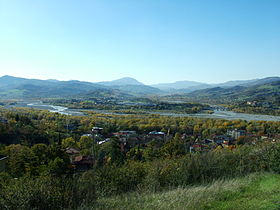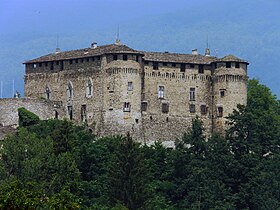| Val di Taro | |
|---|---|
 The Val di Taro at the confluence of the Torrente Ceno and the Taro river (left), with
Fornovo di Taro in the foreground. | |
The Val di Taro in
Emilia-Romagna | |
| Length | 126 km |
| Geography | |
| Location | Comuni of Albareto, Bedonia, Borgo Val di Taro, Compiano, Fornovo di Taro, Solignano, Tornolo and Valmozzola, and parts of Berceto and Terenzo, Borzonasca and Varese Ligure. |
| Coordinates | 44°41′N 10°05′E / 44.69°N 10.09°E |
| Rivers | Taro |
The Val di Taro is the valley of the Taro river, a tributary of the Po. The valley lies almost entirely in the Province of Parma, in the Emilia-Romagna region of Italy.
Geography
The Val di Taro is approximately 126 km long, and runs from south-west to north-east. The source of the Taro is on Monte Penna, on the border between Emilia-Romagna and Liguria. It runs into the Po at Gramignazzo, a frazione of the comune of Sissa. The valley lies between the Val Baganza to the east, the valley of the Vara and the Valle di Magra to the south and the Valle del Ceno to the west. The Parco fluviale Regionale del Taro, or regional park of the Taro river, lies within it, and extends approximately from Fornovo di Taro to Ponte Taro. [1]
History



The Val di Taro is traversed by the Via Francigena, the ancient road and pilgrim route from Canterbury to Rome, which follows the valley from Noceto to the Passo della Cisa. From mediaeval times most of the Val di Taro was held by the Landi family, princes of Val di Taro. Their castle stands at Compiano. In the late 16th century their lands passed into the hands of Ottavio Farnese following a failed conspiracy against the Farnese family in 1582, some thirty years before the more famous Sanvitale conspiracy. Claudio Landi, Prince of Val di Taro, plotted with Giambattista Anguissola and Giammaria and Cammillo Scotti to assassinate Farnese, but the plot was discovered; Landi lost the Val di Taro, and the other conspirators lost their heads. [2]
References
- ^ L'Area Protetta (in Italian). Parco fluviale Regionale del Taro, 2 June 2010. "The protected area". Accessed June 2013.
- ^ [s.n.] (1863) Barbara Sanvitale e la congiura del 1611 contro i Farnesi; Cenni storici, di Federico Odorici, con documenti. Volumetto di pag. 84, in 8.° (book review, in Italian). Archivio Storico Italiano, Firenze: G.P. Vieusseux. Nuova serie 17 (1): 100–106. Accessed May 2013.
| Val di Taro | |
|---|---|
 The Val di Taro at the confluence of the Torrente Ceno and the Taro river (left), with
Fornovo di Taro in the foreground. | |
The Val di Taro in
Emilia-Romagna | |
| Length | 126 km |
| Geography | |
| Location | Comuni of Albareto, Bedonia, Borgo Val di Taro, Compiano, Fornovo di Taro, Solignano, Tornolo and Valmozzola, and parts of Berceto and Terenzo, Borzonasca and Varese Ligure. |
| Coordinates | 44°41′N 10°05′E / 44.69°N 10.09°E |
| Rivers | Taro |
The Val di Taro is the valley of the Taro river, a tributary of the Po. The valley lies almost entirely in the Province of Parma, in the Emilia-Romagna region of Italy.
Geography
The Val di Taro is approximately 126 km long, and runs from south-west to north-east. The source of the Taro is on Monte Penna, on the border between Emilia-Romagna and Liguria. It runs into the Po at Gramignazzo, a frazione of the comune of Sissa. The valley lies between the Val Baganza to the east, the valley of the Vara and the Valle di Magra to the south and the Valle del Ceno to the west. The Parco fluviale Regionale del Taro, or regional park of the Taro river, lies within it, and extends approximately from Fornovo di Taro to Ponte Taro. [1]
History



The Val di Taro is traversed by the Via Francigena, the ancient road and pilgrim route from Canterbury to Rome, which follows the valley from Noceto to the Passo della Cisa. From mediaeval times most of the Val di Taro was held by the Landi family, princes of Val di Taro. Their castle stands at Compiano. In the late 16th century their lands passed into the hands of Ottavio Farnese following a failed conspiracy against the Farnese family in 1582, some thirty years before the more famous Sanvitale conspiracy. Claudio Landi, Prince of Val di Taro, plotted with Giambattista Anguissola and Giammaria and Cammillo Scotti to assassinate Farnese, but the plot was discovered; Landi lost the Val di Taro, and the other conspirators lost their heads. [2]
References
- ^ L'Area Protetta (in Italian). Parco fluviale Regionale del Taro, 2 June 2010. "The protected area". Accessed June 2013.
- ^ [s.n.] (1863) Barbara Sanvitale e la congiura del 1611 contro i Farnesi; Cenni storici, di Federico Odorici, con documenti. Volumetto di pag. 84, in 8.° (book review, in Italian). Archivio Storico Italiano, Firenze: G.P. Vieusseux. Nuova serie 17 (1): 100–106. Accessed May 2013.
